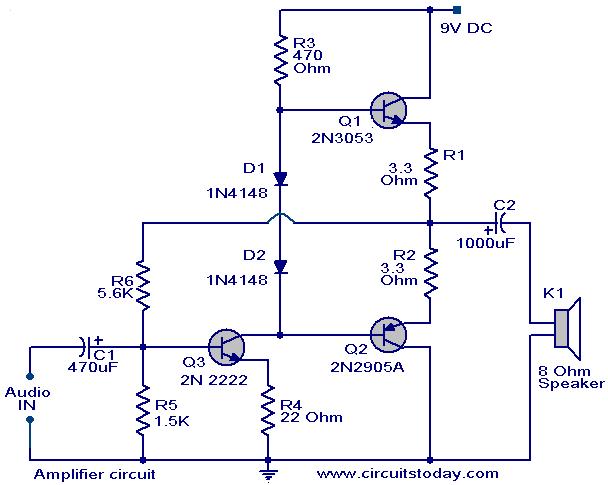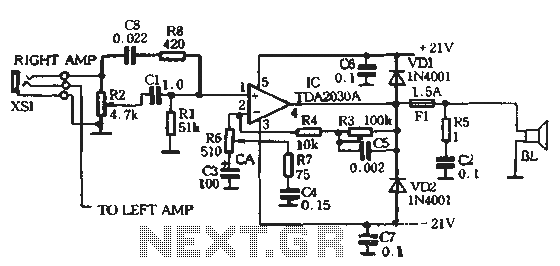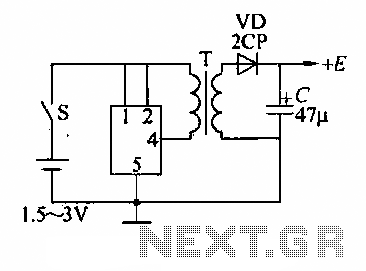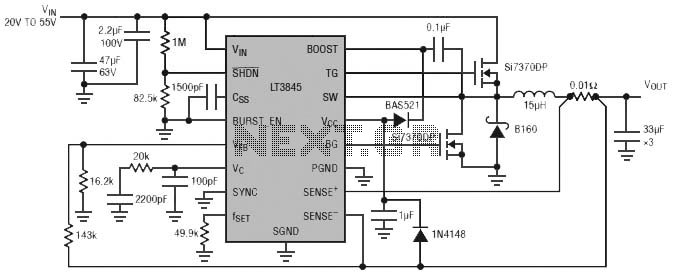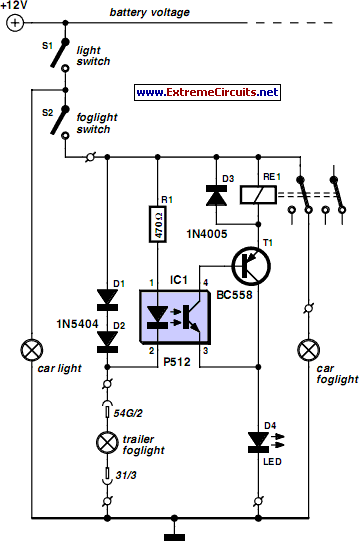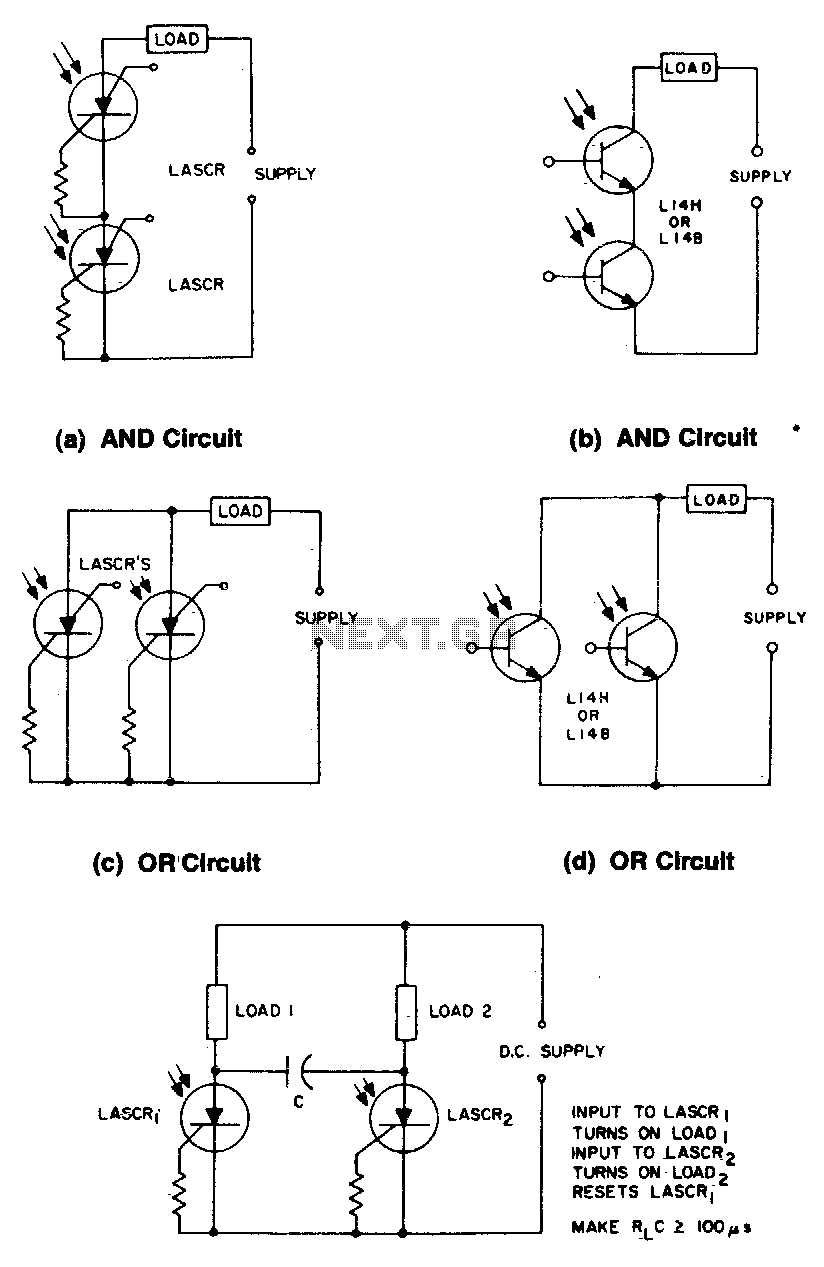
electronic car ignition circuit
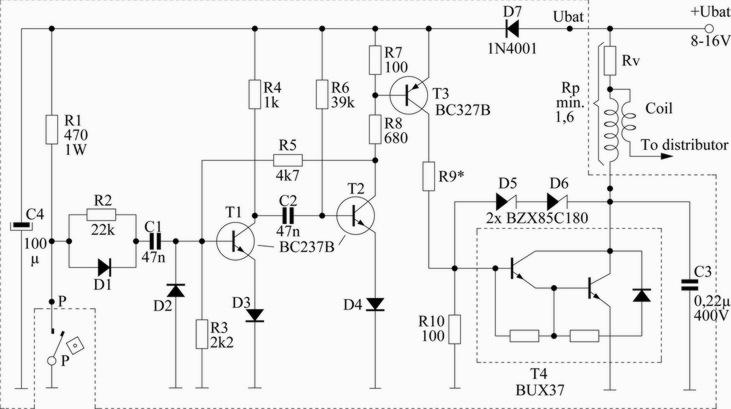
This scheme is designed for a four-cylinder engine. It aims to reduce fuel consumption, increase speed slightly, and minimize the need for frequent access to the distributor cap for contact button replacement, thereby saving costs. Transistors T1 and T2 form a monostable multivibrator, with capacitor C2 and resistor R5 determining the impulse duration of 1.5 milliseconds. Following this are transistors T3 and T4, which are Darlington transistors specifically developed for electronic ignition and function as a switch to control the primary coil. The impulses from switch P activate the monostable multivibrator T1/T2. It is necessary to disconnect the capacitor located in the distributor cap, as it is no longer required. When switch P is closed, T1 remains in the off state while T2 is in the on state, allowing current to flow through the primary coil via T3 and T4. Upon opening switch P, T1 briefly turns on, causing C2 to charge through R6, which leads to a voltage drop on R6 and subsequently turns T2 off. With T2 off, T3 and T4 also turn off, halting the current in the primary coil. As T2 is off, the voltage across R8 increases, which is transmitted through R5 to the base of T1, keeping it in the on state while C2 continues to charge. After 1.5 milliseconds, C2 reaches a level that turns T2 back on and T1 off. At this point, T2, T3, and T4 are again in the on state, allowing current to flow through the primary coil. Resistor R2 and diode D1 are employed to mitigate the effects of impulses generated by the switching of P, which could inadvertently activate the monostable multivibrator. Zener diodes Z5 and Z6, in conjunction with resistor R10, limit excessive voltage spikes caused by the self-induction of the primary coil that could potentially damage T4; these components should be positioned as close as possible to T4. The coil should have a ratio of 1:80 or 1:100 in conjunction with the external resistor Rv, which is utilized for improved cooling. The total resistance value (Rp) of the primary coil and resistor Rv should not be less than 1.6 ohms to ensure that the current through T4 does not exceed 10 A.
The electronic ignition schematic employs a monostable multivibrator configuration using T1 and T2 to generate controlled impulses for the ignition system. The timing of the ignition is critical for optimizing engine performance, and the values of C2 and R5 are chosen to achieve an impulse duration of 1.5 milliseconds, allowing for precise control of the ignition timing.
When switch P is engaged, T1 remains inactive, and T2 is activated, which allows for the conduction of current through T3 and T4, thereby energizing the primary coil. The design ensures that when the ignition switch is opened, T1 briefly activates, allowing C2 to charge through R6, which facilitates the timing mechanism that ultimately turns T2 off. This off state is crucial as it interrupts the current flow through T4, protecting the system from excessive current draw.
The inclusion of R2 and D1 serves to stabilize the circuit by preventing false triggering of the monostable multivibrator due to switch bounce. The Zener diodes Z5 and Z6 are strategically placed to clamp voltage spikes that may occur due to inductive kickback from the primary coil, thereby safeguarding the sensitive components in the ignition circuit.
The choice of a coil ratio of 1:80 or 1:100 is significant as it ensures that the ignition system operates efficiently while the external resistor Rv aids in thermal management. Maintaining a total resistance of at least 1.6 ohms is essential to limit the current through T4 to a safe level, preventing overheating and potential damage to the ignition system. This comprehensive design allows for enhanced engine performance while ensuring reliability and cost-effectiveness in operation.This scheme is for 4 cylinder motor. This will make your car spent less fuel, be a little bit faster and you wont have to frequently open your distributor cap to change the contact buttons thus wasting less money. T1/T2 create one monostable multivibrator in which C2 and R5 determine the length of impulse which is 1, 5 msec.
Next in line are T3 and then T4 which is Darlington transistor specially developed for electronic ignition which is used as a switch to turn on/off primary coil. Impulses from switch P turn on monostable multivibrator T1/T2. You need to un-connect capacitor that is in distributor cap because it is not needed anymore. While switch P is closed T1 is in off state but T2 is in on state, also T3 and T4 which enables current to flow trough primary coil.
When switch P is opened, T1 gets in on state for a moment causing C2 to charge over R6 which makes T2 go to off state because of voltage drop on R6. When T2 is off also T3 and T4 are off and current that was flowing trough primary coil is stopped. Because T2 is in off state, voltage on R8 is increased which is passed trough R5 on T1 base which is still in on state and C2 is still charging.
After 1, 5 msec. C2 value reaches the level where T2 goes to on state again and T1 goes to off state. Now T2, T3 and T4 are in on state, again, and current flows trough primary coil again. R2 and D1 are used to neutralize the effect of impulses caused from «jumping » of switch P which could turn on monostable multivibrator when it shouldn`t. Zener diodes Z5 and Z6 are together with R10 limit overcharged voltage impulses that are caused by self induction of primary coil which could damage T4.
They should be connected as close as possible to T4. Coil should have ratio of 1:80 or 1:100 with external resistor Rv which is used for better cooling. Total resisting value (Rp) of primary coil and Rv resistor shouldn`t be under 1, 6 ohm`s so current trough T4 wouldnt be bigger than 10A. 🔗 External reference
The electronic ignition schematic employs a monostable multivibrator configuration using T1 and T2 to generate controlled impulses for the ignition system. The timing of the ignition is critical for optimizing engine performance, and the values of C2 and R5 are chosen to achieve an impulse duration of 1.5 milliseconds, allowing for precise control of the ignition timing.
When switch P is engaged, T1 remains inactive, and T2 is activated, which allows for the conduction of current through T3 and T4, thereby energizing the primary coil. The design ensures that when the ignition switch is opened, T1 briefly activates, allowing C2 to charge through R6, which facilitates the timing mechanism that ultimately turns T2 off. This off state is crucial as it interrupts the current flow through T4, protecting the system from excessive current draw.
The inclusion of R2 and D1 serves to stabilize the circuit by preventing false triggering of the monostable multivibrator due to switch bounce. The Zener diodes Z5 and Z6 are strategically placed to clamp voltage spikes that may occur due to inductive kickback from the primary coil, thereby safeguarding the sensitive components in the ignition circuit.
The choice of a coil ratio of 1:80 or 1:100 is significant as it ensures that the ignition system operates efficiently while the external resistor Rv aids in thermal management. Maintaining a total resistance of at least 1.6 ohms is essential to limit the current through T4 to a safe level, preventing overheating and potential damage to the ignition system. This comprehensive design allows for enhanced engine performance while ensuring reliability and cost-effectiveness in operation.This scheme is for 4 cylinder motor. This will make your car spent less fuel, be a little bit faster and you wont have to frequently open your distributor cap to change the contact buttons thus wasting less money. T1/T2 create one monostable multivibrator in which C2 and R5 determine the length of impulse which is 1, 5 msec.
Next in line are T3 and then T4 which is Darlington transistor specially developed for electronic ignition which is used as a switch to turn on/off primary coil. Impulses from switch P turn on monostable multivibrator T1/T2. You need to un-connect capacitor that is in distributor cap because it is not needed anymore. While switch P is closed T1 is in off state but T2 is in on state, also T3 and T4 which enables current to flow trough primary coil.
When switch P is opened, T1 gets in on state for a moment causing C2 to charge over R6 which makes T2 go to off state because of voltage drop on R6. When T2 is off also T3 and T4 are off and current that was flowing trough primary coil is stopped. Because T2 is in off state, voltage on R8 is increased which is passed trough R5 on T1 base which is still in on state and C2 is still charging.
After 1, 5 msec. C2 value reaches the level where T2 goes to on state again and T1 goes to off state. Now T2, T3 and T4 are in on state, again, and current flows trough primary coil again. R2 and D1 are used to neutralize the effect of impulses caused from «jumping » of switch P which could turn on monostable multivibrator when it shouldn`t. Zener diodes Z5 and Z6 are together with R10 limit overcharged voltage impulses that are caused by self induction of primary coil which could damage T4.
They should be connected as close as possible to T4. Coil should have ratio of 1:80 or 1:100 with external resistor Rv which is used for better cooling. Total resisting value (Rp) of primary coil and Rv resistor shouldn`t be under 1, 6 ohm`s so current trough T4 wouldnt be bigger than 10A. 🔗 External reference
Warning: include(partials/cookie-banner.php): Failed to open stream: Permission denied in /var/www/html/nextgr/view-circuit.php on line 713
Warning: include(): Failed opening 'partials/cookie-banner.php' for inclusion (include_path='.:/usr/share/php') in /var/www/html/nextgr/view-circuit.php on line 713
